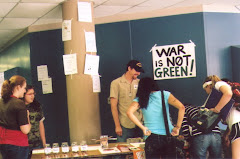This report comes from Arlene Inouye, who is an educator in the Los Angeles public school system and is coordinator of the Coalition Against Militarism in our Schools (CAMS -- see the "Resources" list in the column at left). She attended the Representative Assembly of the National Education Association (NEA) and submitted a New Business Item (NBI) about the use of the Armed Services Aptitude Battery (ASVAB) test in high schools, which gains students' personal information for recruitment purposes.
Arlene writes:
The 87th NEA-RA gathered in Washington DC with political activism taking center stage in the fight for public education in this critical election year. The NEA Representative Assembly is the annual meeting of national delegates representing 3.2 million educators, who make decisions on the beliefs, legislation, policies, and actions of the organization, and elect its leadership. What is striking about the NEA is that it is engaged in a democratic process with 9,000 educators around the nation. It provides an opportunity for grassroots teachers and activists to bring issues of concern with recommended actions and to have an input regarding the core values of the organization.
There were 83 new business items which are calls to action in the next year. They included a variety of topics such as actions to denounce the No Child Left Behind Act, to promote health care reform, support for immigrants and English language learners, and to address social security concerns to name a few. For the past 4 years, CAMS has brought to the RA issues regarding military recruitment. We also have brought issues to the American Federation of Teachers and California Federation of Teachers the other arm of our local United Teachers of Los Angeles (UTLA). The first time we raised Section 9528 of the No Child Left Behind Act in 2004, educators were stunned because they did not know that high schools gave military recruiters the personal information of juniors and seniors.
This year we brought the Armed Services Vocational Aptitude Battery (or ASVAB) to the floor of the RA and in writing. After receiving support from the California delegation the following was proposed and passed by the body of NEA. This new business item states:
NEA opposes mandatory and/or coerced participation of students in the administration of the Armed Services Vocational Aptitude Battery (ASVAB) exam.
Rationale: The primary purpose of the exam is for admission to the Armed Forces. Schools are using this as a means of career exploration. However, the exam is only an assessment of the student’s current knowledge and is not a predictor of inclination toward specific skill sets or interests.
Many speakers came forward to speak for and against the ASVAB, but few objected to oppose its mandatory or coerced participation. One of our UTLA supporters gave a strong statement regarding the targeting of working poor and youth of color by military recruiters with their humvees and slick propaganda. He asked why don’t we see recruiters for doctors, lawyers, engineers in our schools? NEA adopted this legislative amendment.
In summary, the NEA can be an excellent forum to raise issues of military recruitment in the public schools. Many educators told me that they didn’t know about the ASVAB, and thanked me for raising the issue. But the story that touched me the most was a middle school teacher in California who I first met last year at the RA. When I told him about CAMS he told me that he was a navy veteran. He went into the military because in high school his counselor had told him THAT was his only option. Even though he was smart, he was Latino and came from a working poor family. He said that he didn’t know any better and enlisted. He was discharged after he had spoken out against the navy, went to college and became a teacher. He told me that since we met, he has been telling his middle school students about his experience in the Navy, giving them the message that it is not macho and cool to be in the military. He tells them about what it feels like to know that you have dropped bombs that injure and kill persons. His Principal has talked with him about not speaking against the military, but he is not concerned since he is the president of his Teachers’ Union . He thanked me for that initial discussion we had while waiting for a shuttle bus at the RA. It blows my mind to think of all the students that can be potentially touched because educators have been given the information about military recruitment, or have been encouraged to share their own stories.
--Arlene Inouye, CAMS Coordinator http://www.militaryfreeschools.org/, http://www.projectgreatfutures.org/
Wednesday, July 16, 2008
Sunday, July 13, 2008
Flobots Rise

Check out the new "Make our schools military free" page on the social networking site just launched in conjunction with the Flobots CD, Fight With Tools.
"Your weapons are already in hand.
Reach within you and find
the means by which to gain your freedom.
Fight with tools.
Your fate and that of everyone you know
depends on it."
-- from the piece, "We are winning" by Flobots, as read by Minnie Baldwin
Monday, July 7, 2008
Becoming a firefighter
Nice article today from the Austin American-Statesman about Austin Fire Department outreach to high school students.
For students interested in becoming a firefighter, check out this page at the AFD website.
The Fire Department also has a training program at LBJ High School that may be expanded to other schools.
From the Austin American-Statesman:
Austin Firefighters help teach teens
by Tony Plohetski
Monday, July 07, 2008
The children and teens huddled around firefighter Randall Larsen outside the Austin Fire Department training academy, watching and listening as he demonstrated nearly every piece of equipment he uses on the job.
He told them how he and other firefighters connect water hoses, and how they wear special suits to help protect them in burning buildings. Larsen also explained how the force of the water can reach the top of downtown high-rises.
"It's pretty cool," said Ray Gomez, a 15-year-old Travis High School student. "There are a lot of things to learn, like the equipment and everything they have to put on."
But this was no routine demonstration.
The group, made up of about 20 students ranging from sixth-graders to high school seniors, were part of Camp Fire USA's Teens in Action program, in which children from low-income families learn about their community and design projects to meet certain civic needs.
The kids spent the day last month learning how the Fire Department responds to certain emergencies and preparing to create a project using that information, said Cori Stennett, a Camp Fire USA program director.
The students probably are going to design emergency preparedness kits for those who might not be able to afford items such as battery-operated radios, first aid kits and nonperishable food, Stennett said.
This is the first year Camp Fire USA has asked the department to help in its projects. The department is conducting another session this month for another group of students.
Dawn Clopton, an acting assistant chief for the department, said that when Camp Fire USA officials asked for their help this year, department officials saw an opportunity to spread the message of fire prevention and to deliver a pitch to older students about firefighting careers.
"We want to be good and responsible members of the community, and there was no reason to say no," Clopton said.
During their day with the firefighters, the students toured the city's communication center, where 911 operators take emergency calls, and listened to reasons why they might want to become Austin firefighters.
They also learned about the importance of being ready for emergencies.
"It's been really interesting," said Jalal Goggins, a 14-year-old student at Austin High School. "We need to all know this stuff for actual emergencies and how we can help ourselves and other people."
For students interested in becoming a firefighter, check out this page at the AFD website.
The Fire Department also has a training program at LBJ High School that may be expanded to other schools.
From the Austin American-Statesman:
Austin Firefighters help teach teens
by Tony Plohetski
Monday, July 07, 2008
The children and teens huddled around firefighter Randall Larsen outside the Austin Fire Department training academy, watching and listening as he demonstrated nearly every piece of equipment he uses on the job.
He told them how he and other firefighters connect water hoses, and how they wear special suits to help protect them in burning buildings. Larsen also explained how the force of the water can reach the top of downtown high-rises.
"It's pretty cool," said Ray Gomez, a 15-year-old Travis High School student. "There are a lot of things to learn, like the equipment and everything they have to put on."
But this was no routine demonstration.
The group, made up of about 20 students ranging from sixth-graders to high school seniors, were part of Camp Fire USA's Teens in Action program, in which children from low-income families learn about their community and design projects to meet certain civic needs.
The kids spent the day last month learning how the Fire Department responds to certain emergencies and preparing to create a project using that information, said Cori Stennett, a Camp Fire USA program director.
The students probably are going to design emergency preparedness kits for those who might not be able to afford items such as battery-operated radios, first aid kits and nonperishable food, Stennett said.
This is the first year Camp Fire USA has asked the department to help in its projects. The department is conducting another session this month for another group of students.
Dawn Clopton, an acting assistant chief for the department, said that when Camp Fire USA officials asked for their help this year, department officials saw an opportunity to spread the message of fire prevention and to deliver a pitch to older students about firefighting careers.
"We want to be good and responsible members of the community, and there was no reason to say no," Clopton said.
During their day with the firefighters, the students toured the city's communication center, where 911 operators take emergency calls, and listened to reasons why they might want to become Austin firefighters.
They also learned about the importance of being ready for emergencies.
"It's been really interesting," said Jalal Goggins, a 14-year-old student at Austin High School. "We need to all know this stuff for actual emergencies and how we can help ourselves and other people."
Subscribe to:
Comments (Atom)



